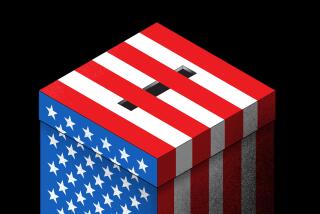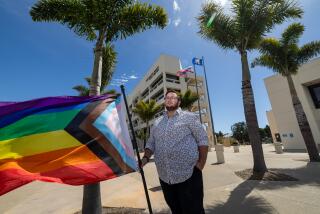Ready, Set Legal Activists Await Bush’s Go
A brown shoe pokes out from under Adam Shah’s desk at the Alliance for Justice. It goes with the blue suit, 40 short, hanging on the back of his door, just in case he has to go on television.
He has never been on TV, but these are unusual times: An otherwise obscure 32-year-old public interest lawyer, Shah has made it his business to know all there is to know about at least three of the individuals rumored to be on the short list of candidates to succeed Justice Sandra Day O’Connor on the Supreme Court.
That blue suit exemplifies interest groups’ extraordinary state of readiness as they await the first high court nominee in 11 years, a marshaling of resources made possible by the Internet and made necessary by the 24-hour news cycle.
Within minutes of a White House announcement, activist groups from both sides will bolt to every news network in an attempt to define President Bush’s nominee in the critical first 24 hours, when the public is most likely to form a lasting impression of the candidate.
For organizations like the Alliance for Justice -- the liberal advocacy group that in 1991, during Clarence Thomas’ confirmation hearings, brought to light Anita Hill’s allegations that he had sexually harassed her -- that means staff lawyers and volunteers are working overtime, compiling dossiers on dozens of potential justices.
Which is why Shah, a senior lawyer with the group’s Judicial Selection Project, can tell you without looking at his notes that Emilio M. Garza is in his late 50s, single, from Texas and conservative. He was a state judge, then a U.S. District Court judge; his decisions have been reversed on appeal a number of times. (“He has some issues.”) He is now a judge on the 5th Circuit Court of Appeals in New Orleans, where he has served since 1991.
Of course, Shah can recite from memory the resume of Atty. Gen. Alberto R. Gonzales -- longtime Bush confidant, former Texas jurist and another Supreme Court contender. But he also happens to know that Gonzales still prefers to be addressed as “Judge” (“which might give a clue to his ambitions”) and that he waited six months before removing the curtain installed by his predecessor at the Justice Department, John Ashcroft, to cover semi-nude statues in the building’s Great Hall.
These days, Shah is working six days a week and missing dinner with growing regularity. His e-mail folder gets automatic feeds from the 5th Circuit, which he combs for any opinions involving Garza, sticking them away in a file.
Edith Hollan Jones, another potential Supreme Court candidate, sits on the same appellate court, so he looks for her name too. Out on the kitchen counter, where other offices might scatter old issues of People magazine, are stapled copies of Jones’ legal opinions, considered riveting reading around here.
Shah took a 75% pay cut to move from a prestigious New York law firm to this office on Washington’s left-leaning Dupont Circle. “I would like to be able to say I helped ensure that the Supreme Court had fair and independent judges committed to the rights and protections that all Americans cherish,” he said, a 1962 leather-bound copy of the Senate procedures on his desk.
Much has changed since the last high court vacancy in 1994, when appellate judge Stephen G. Breyer was swiftly confirmed. Now, the country has the Internet, a round-the-clock news cycle, a deep philosophical divide and battalions of devotees like Shah -- all explosive ingredients for a confirmation firestorm.
Groups on the left meet every Friday morning in an office on Washington’s K Street to share strategies and research. Although abortion rights used to dominate the discussion, now advocates from every spectrum are sharing common cause -- gays, environmentalists, civil rights activists, labor unions and religious groups.
“There is a broader network of organizations working more closely together than at any time in the past,” said Wade Henderson, executive director of the Leadership Conference on Civil Rights, a coalition of about 180 civil rights groups.
They are up against a formidable opponent. Groups on the right that scarcely existed a decade ago now have the ear of the Oval Office, a level of access liberal organizations say they never had under President Clinton.
“We’re in regular consultation with the White House,” said Jay Sekulow, executive director of the American Center for Law and Justice and the evangelical community’s representative on a group of advisors, assembled three years ago, that helps set conservative strategy on judicial issues.
The other members of the group, nicknamed “the four horsemen,” are Edwin Meese III, attorney general in the Reagan administration; C. Boyden Gray, White House counsel to President George H.W. Bush; and Leonard Leo, executive vice president of the Federalist Society for Law and Public Policy Studies, a libertarian think tank whose membership includes about 20,000 lawyers.
“It’s a different world out there, with bloggers and 24-hour news channels,” said Kay Daly, head of the Coalition for a Fair Judiciary, which supports judicial candidates who will, in its view, apply, and not create, law. “It’s not a 9-to-5 fight anymore.”
Within hours of O’Connor’s July 1 announcement that she was resigning, Sekulow sent 1 million e-mails to his supporters. The server hosting the Alliance for Justice’s website crashed more than once from an overload of hits. The Democratic staff of the Senate Judiciary Committee was ready with research compiled on every likely nominee.
Across the political spectrum, briefing books -- some as long as 40 pages -- have been prepared for each rumored name. The information is stored on computer disks and in three-ring binders -- a summary of life stories, public speeches, published interviews, rulings from the bench.
“We’re up and running and well ahead of anything in the last two or three nomination fights,” said Stuart Roy, a consultant with Progress for America, a pro-Bush group. He said his organization had gathered information on 21 potential justices.
“That’s 21 people we feel well prepared to move forward on,” Roy said. But “it could be wrong. It could be the 22nd one.”
As exhaustive as it seems, such preparation is the beginning, enough to ensure that no self-respecting advocacy group is caught flat-footed when Bush ends the suspense.
Once announced, the nominee will come under scrutiny like none before, as lawyers, activists, interns and volunteers now dividing up nearly two dozen names will all converge on one.
Times staff writers Edwin Chen and Janet Hook contributed to this report.
More to Read
Get the L.A. Times Politics newsletter
Deeply reported insights into legislation, politics and policy from Sacramento, Washington and beyond. In your inbox three times per week.
You may occasionally receive promotional content from the Los Angeles Times.






